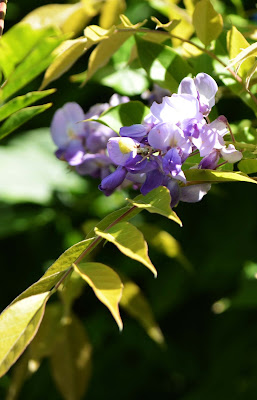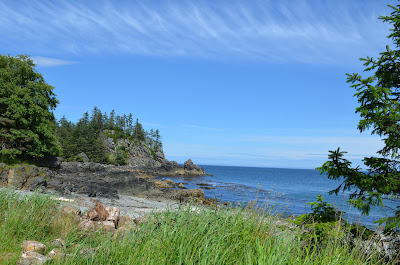We are nearing the fall equinox. The days are shorter, and cooler damper weather has arrived. I don't feel quite ready to give up summer, I am hanging on with this collection of pictures:
a bee is still busy gathering pollen
the dahlias are in bloom
September Midnight
| |
Sara Teasdale (1914)
| |
Lyric night of the lingering Indian Summer,
Shadowy fields that are scentless but full of singing, Never a bird, but the passionless chant of insects, Ceaseless, insistent. The grasshopper’s horn, and far-off, high in the maples, The wheel of a locust leisurely grinding the silence Under a moon waning and worn, broken, Tired with summer. Let me remember you, voices of little insects, Weeds in the moonlight, fields that are tangled with asters, Let me remember, soon will the winter be on us, Snow-hushed and heavy. Over my soul murmur your mute benediction, While I gaze, O fields that rest after harvest, As those who part look long in the eyes they lean to, Lest they forget them. |
the leaves are changing
lots of berries on the holly
but a few summer flowers are still hanging on
my honeysuckle and wisteria have bloomed again
| Autumn Fires | |
| Robert Louis Stevenson (from A Child’s Garden of Verses, 1885) | |
In the other gardens And all up the vale, From the autumn bonfires See the smoke trail! Pleasant summer over And all the summer flowers, The red fire blazes, The gray smoke towers. Sing a song of seasons! Something bright in all! Flowers in the summer, Fires in the fall! |
berries are plentiful on the trees
sunflowers are nearly ready
“Her pleasure in the walk must arise from the exercise and the day, from the view of the last smiles of the year upon the tawny leaves and withered hedges, and from repeating to herself some few of the thousand poetical descriptions extant of autumn--that season of peculiar and inexhaustible influence on the mind of taste and tenderness--that season which has drawn from every poet worthy of being read some attempt at description, or some lines of feeling.”
------------------------------------------
From the studio this week:
"Gated Quails" 12" X 24"
Well that's all for today, thanks for dropping by,
happy Wednesday, with whimsy,
Gillian
















































